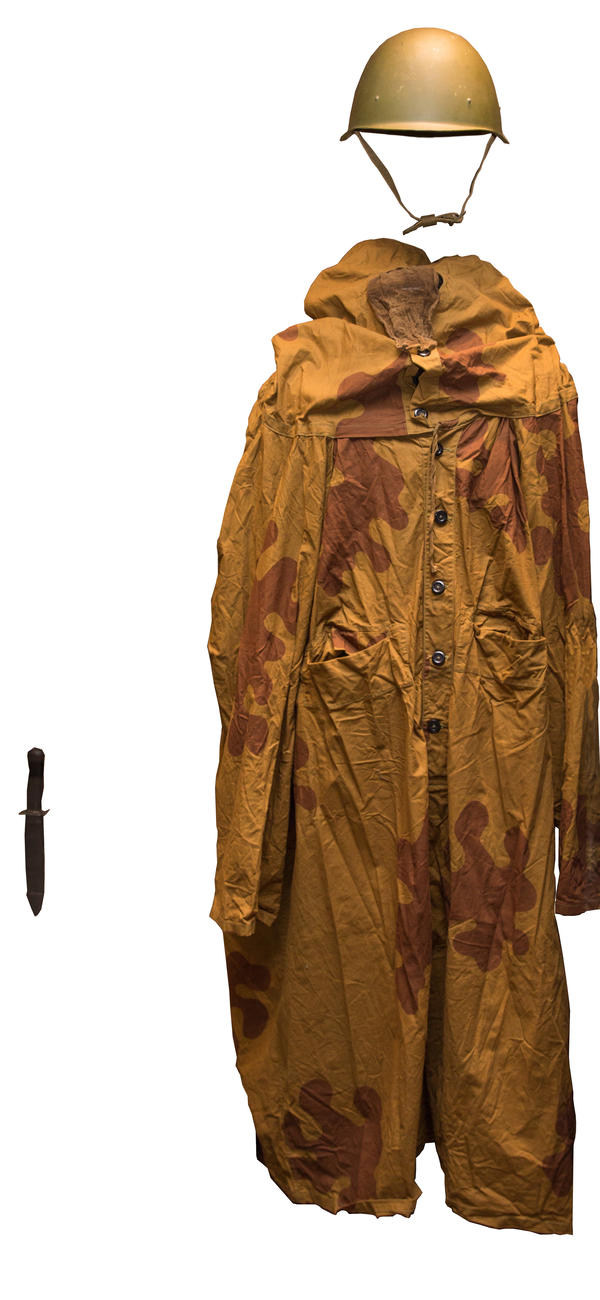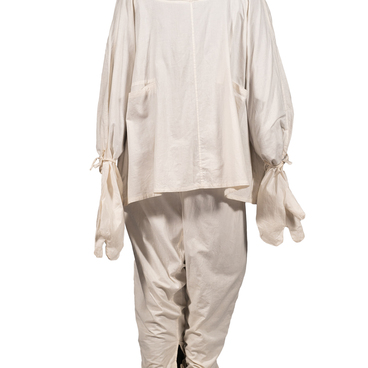Camouflage clothing was adopted by the Red Army before the beginning of the Great Patriotic War. The exhibition of the Victory Museum includes an SSh-40 helmet and an autumn camouflage smock. This gear was widely used during the Great Patriotic War.
Infantry soldiers did not always wear camouflage smocks. In 1925, designers suggested using a white smock with a number of coloring agents. The soldiers would then need to color their clothing themselves according to certain patterns. This smock was not popular among military servicemen and soon fell out of use.
Later, this smock was replaced by a new model — a cape with spots of various colors. Such capes were nicknamed “the amoeba” and were available in four modifications: one for summer, one for spring and fall, the “desert” model for mountainous areas, and the snow-white smock for winter. Such clothing was provided to sappers, reconnaissance scouts, and snipers.
The camouflage smock looked like a long shirt with a hood. In 1943, a new model was designed that resembled a poncho. It was made of colored cloth with dark spots. Its design mimicked natural vegetation. The most popular pattern was made to look like leaves and was known as “the palm”.
Camouflage smocks had a very simple design. Each suit was intended to be used only once or twice. The smock was put on over the head. The cutouts and patterns were designed by a special camouflage department, and the smocks were hand-sewn.
Apart from the camouflage clothing, soldiers also needed protective equipment. A steel helmet protected the head against rifle bullets, as well as fragments of artillery shells and shrapnel. The SSh-40 helmet consisted of an outer shell, a liner, and a chinstrap. The covers for helmets were made of the same cloth as the camouflage smocks. After the war, steel helmets were transferred to training organizations and civil defense forces.
In combat, soldiers used camouflage clothing when trying to locate the enemy’s defenses and gun posts. The camouflage was one of the factors that ensured the successful crossing of the Dnieper.
Infantry soldiers did not always wear camouflage smocks. In 1925, designers suggested using a white smock with a number of coloring agents. The soldiers would then need to color their clothing themselves according to certain patterns. This smock was not popular among military servicemen and soon fell out of use.
Later, this smock was replaced by a new model — a cape with spots of various colors. Such capes were nicknamed “the amoeba” and were available in four modifications: one for summer, one for spring and fall, the “desert” model for mountainous areas, and the snow-white smock for winter. Such clothing was provided to sappers, reconnaissance scouts, and snipers.
The camouflage smock looked like a long shirt with a hood. In 1943, a new model was designed that resembled a poncho. It was made of colored cloth with dark spots. Its design mimicked natural vegetation. The most popular pattern was made to look like leaves and was known as “the palm”.
Camouflage smocks had a very simple design. Each suit was intended to be used only once or twice. The smock was put on over the head. The cutouts and patterns were designed by a special camouflage department, and the smocks were hand-sewn.
Apart from the camouflage clothing, soldiers also needed protective equipment. A steel helmet protected the head against rifle bullets, as well as fragments of artillery shells and shrapnel. The SSh-40 helmet consisted of an outer shell, a liner, and a chinstrap. The covers for helmets were made of the same cloth as the camouflage smocks. After the war, steel helmets were transferred to training organizations and civil defense forces.
In combat, soldiers used camouflage clothing when trying to locate the enemy’s defenses and gun posts. The camouflage was one of the factors that ensured the successful crossing of the Dnieper.



